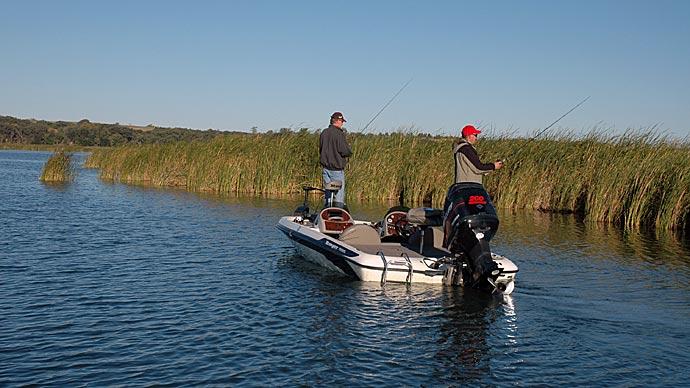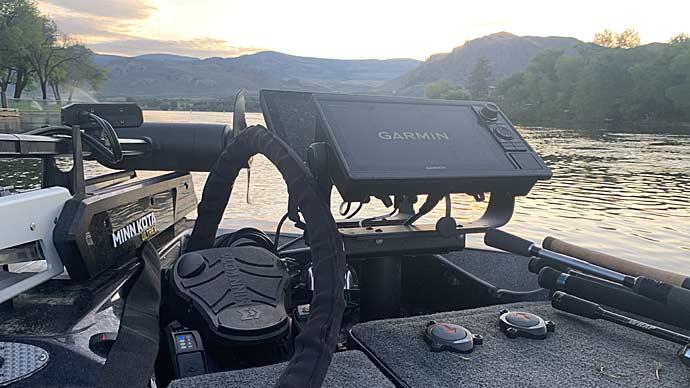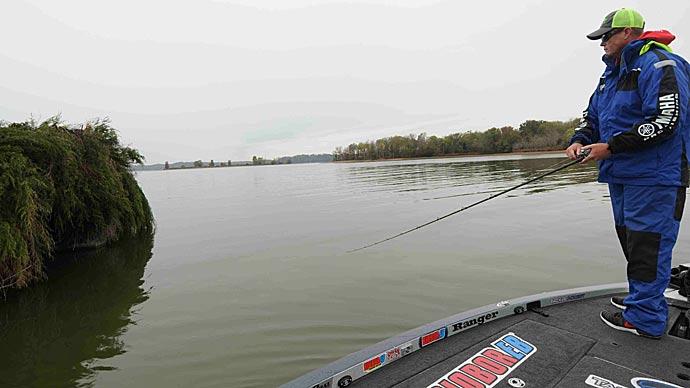
Can you believe the title of this article? It wasn't long ago that we didn't call electronics "fish finders," they were depth finders, and a flasher was the only depth finder priced for the average angler. Today, we talk about pixel counts, sensitivity, high-power transmitters, and specialized transducers. Fish finders now range in price from under $300 to over $2,000.
Scores of options are on the market for those wanting to buy a piece of modern-day electronics. And with those options comes the real question, 'Will any of this new-fangled technology help me catch more fish?
"Yes," said Aaron Martens, Don Iovino, Penny Berryman, and Greg Hines. They all believe the new electronics will help. So we asked each noted professional to describe how they use their fish finders to identify fish and their prey.
"People don't believe me when I tell them most of the fish I catch some days are 'graph' fish," says Aaron Martens. (A "graph" fish is located using a fish finder and eventually caught.) "Back East, they don't seem to use their electronics like we do out West. I'm lost if I don't have a good set of electronics on my boat.
"Over the years, I've learned to tell the difference, most of the time, between stripers and largemouths, and shad and other types of minnows. It didn't happen overnight, and a lot of trial and error led me to my conclusions. For example, stripers move faster than largemouths and don't stay on the screen as long. Many people think all fish show up as an arch on the screen, but largemouths often appear with just a straight line."
Martens uses a a high-definition fish finder to identify what's under his boat. He believes you must know what's down there to be consistent.
"You need sonar equipment with enough pixels," says Don Iovino. "And what a pixel is, is how many little squares are in an inch. The more squares, the better the picture. The new generation of depthfinders has an unbelievable picture. The picture quality is critical to identifying what's down there."
"By watching the differences between the various scratches and lines on the meter, you can determine what fish species you're charting, whether stripers, carp, or bass. Carp are short, fat marks that swim slower than other fish and have a great deal of gray line associated with them. Stripers appear as long dotted lines, with much more movement, and largemouths appear as straight lines, maybe dots, or scratches."
"Baitfish will show up in gray line, in circles, and are usually herded by other fish or coming up to the surface. Baitfish in the ocean move in circles as well."
"The most obvious way to know what's on your screen is to be observant," says Penny Berryman. "If there is active bait in the area you're fishing, you can pretty well tell what's going on under your boat.
"Just today, I watched a local Crane-type bird, and it picked up a rather large Gizzard shad. That told me what those marks were on my screen. They were too small for bass but too large for threadfin shad. These gizzard shad were around 11 inches long. If I had not observed the crane, I could have wasted valuable time chasing bait instead of bass."
Here in the West, several different baitfish species inhabit most of our waters, each with slightly different characteristics. Threadfin shad, crappie, bluegills, carp, and smelt are the most common, while many lakes have unique forage. Is it possible to distinguish between each of these many species?
"That gets a little more complicated," says Iovino. "Gizzard shad, for example, are larger than threadfin shad and show up more in straight lines than circular clouds. Crappies and bluegills look like little Christmas trees and relate differently to cover. The more time you spend learning bodies of water, and the more time you spend being aware of the environment, the easier time you'll have identifying what's down there."
"Different species of baitfish appear on the screen differently mainly because of how they relate to structure," says Penny Berryman. "Crappie and bluegill want to stack on top of one another next to the structure. They look like little pancakes."
Greg Hines has spent thousands of hours scuba diving the West. He has seen almost all western species of fish in their environments; how they relate to structure, how they school, and how they behave.
"One of the most interesting things I learned while scuba diving, that later I verified on my electronics," Hines says, "was how to identify schools of larger-size shad. It is apparent that larger shad school different than smaller ones. They form a tube rather than a tight ball. By noticing these differences later on my graph, I have been able to focus on larger bass feeding on the larger shad."
Thirty-plus years in the bass fishing business have taught these professionals the behavior of not only bass but also the forage they eat.
"You must learn to trust your electronics," says Berryman. "I have been with Humminbird and now Zercom for many years. I trust what my finders show. The new finders are so sharp. I don't think they miss anything. I rely so much on the electronics that I have two finders on my boat's front and two back. A mishap in a tournament years ago left me without a functioning transducer. That's when I decided never to be without."
Today, advanced electronics allow people to take shortcuts to the age-old method of spending time on the water, allowing them to jump right to the bottom line. However, if you don't know how the fish you seek behave, you could waste valuable time targeting the wrong fish.
"One of the ways to tell a novice angler from more experienced ones," says Berryman, "is to listen for the beeper that goes off each time a fish goes under the boat. Anglers new to electronics don't often understand that any fish will cause that beeper to activate. If they don't know what species they're after, that little beeper will drive them crazy. The first thing I'd do is turn that beeper off."
Even with a few negatives, fish finders allow even the novice angler to learn much quicker than previous generations of anglers not blessed with such a wide variety of technological advances. Adding to this revolution is the development of underwater cameras. Greg Hines used one of these to help identify some dots that kept appearing on the screen of his finder in the Columbia River last fall.
"I kept seeing little dots on the screen but couldn't figure out what they were. So, I dropped the camera and was amazed to see baitfish, some shad, not herded up, but rather feeding up from the bottom, much like trout feed. I could pattern these fish, and whenever I saw those dots on my finder, I knew the smallies would be somewhere close."
Many anglers have had similar experiences with other baitfish. Perch, for example, during their prespawn in late winter, will bunch tightly together and run in continuous straight lines on the screen. During the summer, when the perch aren't as congregated, smaller pockets can be found using a finder that will alert the angler to the possibility of large and smallmouth bass waiting nearby.
Each species of baitfish or sportfish possesses unique characteristics. Although you may be able to take a shortcut or two in understanding what is displayed on your electronics, there is no substitute for good ol' hard work and practice.
"Sometimes, catfish can be mistaken for bass," says Aaron Martens. "The best way I've found for determining what's down there is to fish for them. I've dropped down and hooked a catfish before when I thought I had graphed a largemouth. Then, over time, I realized that schools of catfish are in rigid columns on the screen; they are a little different from bass, and most of the time, I can now tell the difference."
Whether shad, crappie, bluegills, carp minnows, smelt, or some species popular in your area, it is the consensus of the pros that you can use your electronics to identify forage. Spend time charting water with your big motor and your trolling motor. Be mindful of your surroundings, the structure, the shorebird, and surface bait activity. Do that and develop confidence in your choice of electronics, and you will be able to maximize the dollars you have or will spend on today's advanced electronics.
Reprinted with permission from Bass West Magazine




